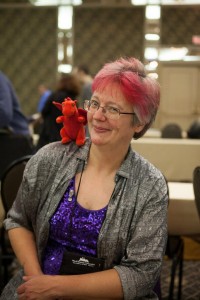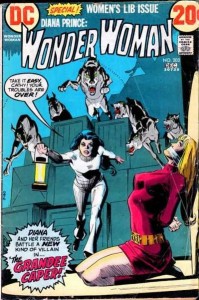
 (This originally appeared on the SFWA blog.)
(This originally appeared on the SFWA blog.)
Goodreads is the largest reader community site in the world, with over thirteen million members. Goodreads was recently acquired by Amazon, creating worries that the site would change, but Amazon has said they do not intend to make changes. Users can track their reading, find or make book recommendations, and discuss what they’re reading. Goodreads lists self-published books as well as those from professional presses.
Goodreads reaches outside its own site, supplying reviews to Powell’s Books, USA Today, the Los Angeles Public Library, the Columbus Metropolitan Library, and Kobo, among others. It supplies lists of books to the popular website Listopia, such as “Best Books of 2012.”
Beyond that, however, Goodreads offers authors tools that they can use to promote books. Using Goodreads, you can create giveaways, post excerpts, and help Goodreads readers discover your books.
When someone joins Goodreads, they create a profile that shows their reading side. Your profile includes optional information such as a photo, location, date of birth, website, reading interests, and a brief bio. Fill it out but be aware that after you’ve added an author profile, the second profile will be what most people see, rather than this one.
Goodreads allows you to maintain lists of what you’ve read, what’s on your to-read list, and what you’re currently reading. Each of these is referred to as a shelf.
You also have a newsfeed, which is displayed on your Goodreads home page, and shows recent news from friends and authors you are following as a fan. You can see what Goodreads events they are attending, whose reviews they are following, when they rate, add, or review a book, and so forth.
As a writer, you can expand your basic profile by adding an author profile and joining the over sixty thousand authors participating in the Goodreads author program. How do you add an author profile? It’s simple. Find one of your books on Goodreads and look for the “Is this you?” link at the bottom. Click on that to claim the book. It will take a few days for Goodreads to confirm you are the author, but they will mail you when your profile has been updated.
Now that you’re a Goodreads author, you’ve got access to a dashboard of new and interesting tools. On the home page, click on “Visit your dashboard,” which should appear near the top on the righthand side. The page that opens up should have Author Dashboard up in the top righthand side under the Goodreads toolbar. You’ll see it displays stats like number of works, which is the number of works attributed to you, and the number of fans and friends.
That section may seem a little mystifying. What’s the difference between “added by unique users,” “fans,” and “friends”? When you are looking at someone’s profile, you can opt to become a fan or add them as a friend. (If they’re not a Goodreads author, the option to add them as a friend will not appear. Goodreads automatically creates pages for authors.) If you are friends with someone, both people have to have approved the relationship, and each will have their reviews and comments displayed in the other’s newsfeed. If you are a fan of someone, their reviews, comments and blog posts will appear in your newsfeed, but they will not see yours. Added by unique users does not affect your newsfeed at all but is the number of people who have added one or more of your works to one of their shelves.
You’ll see all of your works listed in the “My Books” section under your statistics, along with statistics for each, including the number of ratings, the average rating, the number of Goodreads reviews, how many people have it on their to-read shelf, and how many people have it on their currently-reading shelf. You can drill down on each listing: while I don’t believe you can currently add ebooks, you can edit the book’s information and see Goodreads statistics for how many people have added, rated, reviewed, or included that title on their “to-read” list.
Beneath that is your blog. I am still looking for an easy way to push a WordPress blog post to one’s Goodreads blog, but so far I haven’t found one. There are plenty of Goodreads related WordPress plugins (http://wordpress.org/extend/plugins/tags/goodreads) but the majority of them allow you to display data from Goodreads on your site, such as a list of what you’re currently reading. Generally I mirror a few, but not all of my blog posts, here, because it’s a pain in the butt.
One of the most useful Goodreads Author Tools is their Giveaway system. Go to their giveaway page and you’ll see a wide variety of giveaways, which you can sort by which are ending soon, which are most requested, which are from popular authors, and what’s been recently listed. Goodreads makes it very easy to enter giveaways and allow requesters to add the book to their to-read shelf/. You can set the dates for the giveaway, as well as what countries it’s available in, if you don’t want the cost of shipping something overseas. It does not cost anything to list a giveaway, but be prepared to follow through. You cannot give away e-books as a giveaway, so you will have to bear the cost of shipping.
This is handy because Goodreads promotes the giveaways for you. Over 40,000 users sign up for giveaways on a daily basis, according to Goodreads, which means that mentions of your giveaway are appearing in the newsfeeds of their friends, as well as being accessible from the main giveaway page.
For the best experience, I suggest going through GoodRead’s Author Tutorial, as well as the abundance of other documentation they’ve provided. You’ll want to investigate groups as well as how to run an author Q&A. You can create trivia questions that drive interest in your book or publicize book signings and other promotional events. You may want to add some of its widgets to your blog or website or even pay to use its Self-Serve Advertising platform.
Enjoy this advice about social media for writers and want more content like it? Check out the classes Cat gives via the Rambo Academy for Wayward Writers, which offers both on-demand and live online writing classes for fantasy and science fiction writers from Cat and other authors, including Ann Leckie, Seanan McGuire, Fran Wilde and other talents! All classes include three free slots.
Prefer to opt for weekly interaction, advice, opportunities to ask questions, and access to the Chez Rambo Discord community and critique group? Check out Cat’s Patreon. Or sample her writing here.
...
 Once you’ve mastered the basics of getting words on a page and moving characters around through situations, there’s some things that (in my experience) the majority of writers need to focus on. Examples are narrative grammar, paragraphing strategies, trimming excess from sentences, and getting inside a character’s head. Here, I’m going to discuss the last of those.
Once you’ve mastered the basics of getting words on a page and moving characters around through situations, there’s some things that (in my experience) the majority of writers need to focus on. Examples are narrative grammar, paragraphing strategies, trimming excess from sentences, and getting inside a character’s head. Here, I’m going to discuss the last of those.
A lot of this is taken from correspondence with my student Hasnain. He’d asked about story structures, particularly Freitag’s Triangle, and we’d discussed where the triangle occurs in Junot Diaz’s story, Fiesta 1980. In looking at his most recent story, I’d said I thought he needed to get inside his main character’s head more.
Hasnain asked: You mentioned today that going into the narrator’s head is a good thing since it helps the reader seat more firmly with the narrator. However, here’s where I am a bit confused. I read somewhere that what people think and feel should be shown in a sensory way through their actions and interactions with others. If I go into the narrator’s head, wouldn’t I be telling? In my story, this would be if the narrator thinks about how he wants to put Sal’s love to the test.
My reply:
Let’s go back to Fiesta. Here’s some places where I think we’re particularly inside the narrator’s head and seeing his thoughts.
...

And I’m really happy with it, but holy cow, is it hard to rewrite a novel. Because you’ve got to manage it all in your head while working with smaller parts of it.
I was trying to think of a comparison to make to Wayne, who is a software developer. And actually, it’s a lot like working on a large program with pretty of submodules and pieces, because when you change one section you need to figure out how it affects all the other pieces. And there’s repeated objects, or other things, and I think a little of those like global variables, so to have to make sure they’re declared before you can start using them. (As you can tell, I spent some procrastination time on thinking this out.)
Something I’m doing, which is probably rather insane of me, is that I transferred the book, which was in a Word doc, back into Scrivener. That’s because I have been severely reordering the scenes. I printed it all out, and went through that hardcopy with pen marking up some stuff and shuffling it around until it was all in the order I wanted it in.
Part of that is the process for dealing with what I’m comparing to global variables. That’s a thing that gets referenced more than once over the course of the book. Because you want it set up right the first time it appears and then for details to unfold about it in an order that makes sense and keeps building on the thing.
...
 Here is the only thing I know to be true about writing advice: none of it is 100% true. There are always exceptions, always idiosyncrasies of individual process.
Here is the only thing I know to be true about writing advice: none of it is 100% true. There are always exceptions, always idiosyncrasies of individual process.
Here is the smartest piece of writing advice I ever got: said by Syne Mitchell while I was at Clarion West in 2005, “Try different things, find what works for you, and do that. Lots.”
Writers should pay attention to our own process. Sometimes we’re reluctant to do so. We worry that like the centipede in the story who stops being able to walk after thinking about exactly how she does it, looking at our own process will damage or kill it. A Schrödinger’s cat: we know we’re doing something, but if we look to prove that, it’ll vanish.
This is not actually true. Looking will, most probably, not kill it. If you are the rare exception that cannot look at their process without damaging it, a brief examination will let you know this without damaging anything too much. Maybe. There are no guarantees in writing advice.
But if you are part of the vast majority that WILL learn from it, what will you gain?
...

The key points were:
Enjoy this writing advice and want more content like it? Check out the classes Cat gives via the Rambo Academy for Wayward Writers, which offers both on-demand and live online writing classes for fantasy and science fiction writers from Cat and other authors, including Ann Leckie, Seanan McGuire, Fran Wilde and other talents! All classes include three free slots.
Prefer to opt for weekly interaction, advice, opportunities to ask questions, and access to the Chez Rambo Discord community and critique group? Check out Cat’s Patreon. Or sample her writing here.
...
 A metaphor that I was exposed to at Clarion West (now nearly a decade ago) still works beautifully for me, and it’s one I use when teaching: the idea of the writer’s toolbox.
A metaphor that I was exposed to at Clarion West (now nearly a decade ago) still works beautifully for me, and it’s one I use when teaching: the idea of the writer’s toolbox.
In my mind’s eye, it’s a big red metal tool chest, small enough to be carried around, large enough that you wouldn’t want to HAVE to carry it around all the time. Inside, drawers lift out to reveal neatly packed devices and tools, each in their own padded slot.
There’s a blade capable of lopping off awkward paragraphs, and sharper, tinier words designed for work at the sentence level, trimming beginnings till they catch a reader like a fish hook and pull them into the story. There’s a box of punctuation marks, with a special slot for the semicolons. There’s the intricate device of an unreliable narrator, calculated to wobble like a gyroscope yet still remain true to the story’s course. There’s a set of filters, each one a specific point of view, each letting you cast a section in a different light. And a layer of ornamental gadgetry: epigraphs and scraps of poetry. And a valuable gimlet, capable of drilling down to a character’s motivation: the question, “What does s/he WANT?”
Even this metaphor’s a device (and if you want to know more about metaphor, I can do no better than point you at Chuck Wendig’s excellent piece, in which he’s said everything I’d say and then quite a bit more).
I’ve been thinking about it in going over notes for the class on Literary Techniques in Genre Fiction, because my aim in that is two-fold: to give students not just a whole bunch of new tools, but some sense of when to use them and a chance to experiment with them. Because a device shouldn’t be separate from a story, but an integral part of it, something that adds more to it than just a chance to see the writer being clever.
To push the metaphor a little further, stories are like furniture, only without the useful part, like being able to sit on them. You want them to feel like a single piece, not a table with some drawers and ornamental hinges glued on it. In the class, I try to introduce new tools students may not have (consciously) worked with before, including defamiliarization, hyperbole, synthesia, and a lot of other fancy words. And I also try to expand a drawer they’ve already got partially filled: sources of creative inspiration.
Enjoy this writing advice and want more content like it? Check out the classes Cat gives via the Rambo Academy for Wayward Writers, which offers both on-demand and live online writing classes for fantasy and science fiction writers from Cat and other authors, including Ann Leckie, Seanan McGuire, Fran Wilde and other talents! All classes include three free slots.
Prefer to opt for weekly interaction, advice, opportunities to ask questions, and access to the Chez Rambo Discord community and critique group? Check out Cat’s Patreon. Or sample her writing here.
...
 We’re currently covering characters in the Writing F&SF class, so I thought I’d pull out a little from my notes.
We’re currently covering characters in the Writing F&SF class, so I thought I’d pull out a little from my notes.
Some simplistic stories have characters that seem like placeholders, as though any individual could fit into that slot. Fairy tales, for instance, tend to have generic characters: the princess, the prince, the witch that have little dimensionality to them. One delightful strategy for working with them, in fact, is to pick a character and flesh them out to the point where they shape the story.
That is the most important thingL: characters must shape the story. They need to influence the action and make the narrative one that could only happen to them.
Let’s take a simple plot: a character must escape zombies. Our first character, a survivalist, keeps two shotguns in her apartment and is steel willed to the point where she is capable of cutting off a limb to avoid infection by zombie bite. The second is a meek-mannered scientist who faints at the sight of blood but is capable of building marvelous devices. The story and what happens in it is very different depending on which character gets put into the situation.
What happens in the story should be the result of what your character does, and her/his actions are dependent on both their personality and what they want. Vonnegut tells us every character in a story needs to have something they want, even if it’s just a glass of water. Because what they want dictates what they will do while their personality decides how they will go about doing it. You’ll also want to keep in mind that humans, like water, follow the path of least resistance. They will usually pick the easiest way before moving onto to something harder if it fails them.
Stuck and wondering what your character will do next? Think about what they want and how they might try to get it. (Then how you will thwart them, because the more you put that character through, the more your reader will come to know and identify with them.)
Look at your favorite characters and see how the writer communicates their nuances. Some of my favorites:
Who are your favorite characters and why?
Enjoy this writing advice and want more content like it? Check out the classes Cat gives via the Rambo Academy for Wayward Writers, which offers both on-demand and live online writing classes for fantasy and science fiction writers from Cat and other authors, including Ann Leckie, Seanan McGuire, Fran Wilde and other talents! All classes include three free slots.
Prefer to opt for weekly interaction, advice, opportunities to ask questions, and access to the Chez Rambo Discord community and critique group? Check out Cat’s Patreon. Or sample her writing here.
...

A reason the interview wa so enjoyable was that they asked really interesting, incisive questions about the stories in Near + Far, in that way a writer desires and dreads at the same time, where they’re seeing some of your psyche’s underpinnings shaping the stories that you create. I’ve been mulling over some of those questions since then, and was thinking about one on the bus home the other day.
They pointed to many of the stories being about the need for connection, with characters like the protagonist of “Angry Rose’s Lament” being addicted to a drug that makes him feel connected, the hero of “Therapy Buddha” projecting all his needs onto a toy, or Sean Marksman’s ultimate fate in “Seeking Nothing.” Going through other stories in my head, I see the theme of connection coming up in various forms throughout. I think that’s a basic human need, one born of monkey roots, an instinct to be with the other monkeys.
...

Overall
Writing is a skill – like any other skill, you get better and more efficient at it. Successful writers write steadily. Don’t worry about speed. Think of every word written down as one closer to your goal.
Writing is also a cyclical process. Ideas are generated and get fed back in. Don’t sweat the messiness as this process is underway because readers will never see anything but the final results. No first draft will be perfect.
Day One
Describe one character with 5-7 single sentences that each describe him/her/it in a specific area, such as their love life, education, current situation, occupation, hobbies, problems, etc.
Day Two
For each of your sentences, write two more sentences that each on it, creating a paragraph about each area of description.
Day Three
Write a single sentence about each life area that runs counter to the previous sentiment. For example, a paragraph about how the character really wants children might have a sentence about how they’re sterile. A paragraph about how they’re happily married might merit a sentence about feeling attracted to the new office manager at work.
...

So now I’ve worked my way through BEST SERVED COLD and am on the third volume of the First Law trilogy, which starts with THE BLADE ITSELF (and I can tell I’m going back to read both of the first two, in order to see better how they fit with the First Law trilogy). I’ve got to say, gee whiz, when Delany is talking about how you can only write stuff as good as the best stuff you’re reading, this is the sort of thing he’s talking about, because I know I’ve learned a good bit about the subject matter mentioned in the title from looking to see how Abercrombie does it.
...
Want access to a lively community of writers and readers, free writing classes, co-working sessions, special speakers, weekly writing games, random pictures and MORE for as little as $2? Check out Cat’s Patreon campaign.

"(On the writing F&SF workshop) Wanted to crow and say thanks: the first story I wrote after taking your class was my very first sale. Coincidence? nah….thanks so much."

(fantasy, short story) Even Duga the Prestidigitator, who never pays much attention to anything outside his own hands, raised an eyebrow when I announced I’d be hooking the manticore up to my wagon.


This site is protected by reCAPTCHA and the Google Privacy Policy and Terms of Service apply. This site is a participant in the Amazon Services LLC Associates Program, an affiliate advertising program designed to provide a means for sites to earn advertising fees by advertising and linking to Amazon.com.